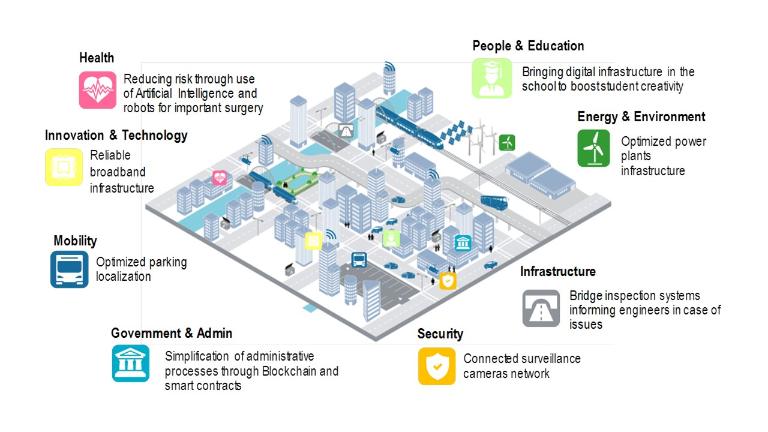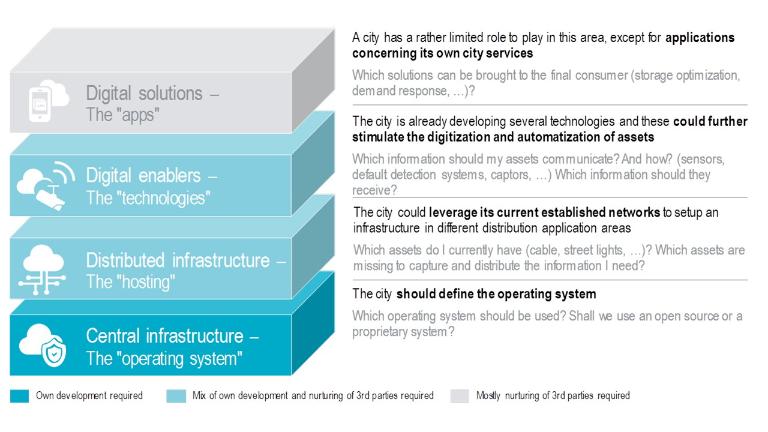

How the Smart City can build itself
The smart city hype has cities and companies scrambling for digital initiatives. Drawing a parallel with smartphone manufacturers, we argue that the smart city should build itself.
A Smart City is an ecosystem that enables the development and growth of applications that could improve (1) people's quality of life, (2) planet sustainability and (3) a city's finances.
The digital solutions should help the city in improving the quality of life of its citizens by fulfilling their human needs: physiology, safety, belonging, esteem and self-actualization. Secondly, the solutions should help the city in preserving resources, reducing emission/waste and growing public green space to enhance the protection of the planet. Finally, Smart City applications need to be financially sustainable, fueling economic growth by increasing the efficiency of public services, increasing their value and exploiting new business opportunities.
In a successful Smart City, a joint approach and strategy with involvement of all city council departments is required to avoid an incoherent package of standalone solutions. All departments have a role to play in a Smart City and will benefit from newly developed smart solutions for their specific responsibilities.

Key building blocks of a Smart City
In order to understand the key building blocks of a Smart City, an analogy with a smartphone is made. A smartphone consists out of four key building blocks:
1) Operating System, defining the basic rules and protocols to support the development of the other building blocks and to structure the cooperation between them (e.g. iOS, Android etc.),
2) Connectivity, providing the transmission and the storage of all data used by the technologies and applications (e.g. Wifi, Cellular etc.),
3) Technologies, the collection of multimedia elements and sensors that can be remotely monitored or manipulated (e.g. camera, microphone etc.) and
4) Applications, the user services built with the (combination of) technologies (e.g. Waze, Instagram etc.).
A smartphone delivers the necessary building blocks enabling third parties to develop applications, rather than developing applications themselves, improving the attractiveness of the smartphone as a whole. Apple and Google for example, chose to focus their development efforts on the operating systems iOS and Android, while partnering with specialists for technology and connectivity and leaving development of applications to third parties. Just as a smartphone, a Smart City should develop and/or nurture the same necessary building blocks to enable and stimulate third parties to develop applications.

More precisely, if we translate the building blocks to a Smart City context, a Smart City should consist out of the following four blocks:
1) Central infrastructure, the assembly of technological choices, policies, underlying systems etc. to govern and stimulate the creation of connectivity, technologies and applications (e.g. Legal framework, business models etc.),
2) Distributed Infrastructure, the telecommunication network and data services allowing the capturing, transmission, storage, analysis and commercialization of data in a secure and efficient way (e.g. 4G, WiFi etc.),
3) Digital Enablers, the integrated set of city assets and technologies that are generating and transmitting data as input for the smart solutions (e.g. CCTV, smart waste bins etc.) and
4) Digital Solutions, the smart plug 'n play solutions improving people's quality of life, planet sustainability and city's profits (e.g. adaptive traffic lighting, optimized waste management etc.)
Role of the different players in a Smart City
For the successful development of a Smart City, a coordinated approach is needed, with significant actions to be fulfilled for the development of all building blocks. For each building block, specific players will be responsible in the overall Smart City ecosystem:

For the Central Infrastructure, the main role is to be played by the local and national governments. They should define the long-term strategy and coordinated approach for the Smart City with clear objectives and a roadmap. They will set the rules of the game for all players, with for example an open data policy for remote management of the city assets, to be leveraged by third parties in their applications. A dedicated function within these public institutions should be created, leveraging all specialized knowledge of the specific council departments.
To develop the Distributed Infrastructure, the current capabilities in terms of big data and connectivity should be identified first. The right Telecom players should be attracted and stimulated to further develop the connectivity and data storage capabilities within the city, as key requirements for the development of applications. Investments will be needed in networks and software to cope with a significant increase in the number of smart devices and the new data traffic streams they create. Their networks will have to deliver significantly higher performance to be able to deliver critical data services.
To build the network of Digital Enablers, both technology players and other industrial players will be key partners for the governments. The network of digital enablers will consist out of both new digital connected assets (e.g. self-driving cars, parking availability sensors, waste bin sensors etc.) and existing city assets turned into a connected asset connected with the city's big data platform (e.g. CCTV images, luminaires etc.). Technology players will need to develop new smart assets and ensure that the necessary existing city assets become smart, by connecting them with the central data framework and with other smart assets.
For the Smart Solutions, both Start-ups and established companies will play an important role in their development. Both will be in the lead to develop new Smart Solutions, building on the Distributed Infrastructure and the Digital Enablers to provide a solution improving one of the three objectives of a Smart City.
Let's act
In conclusion, cities should build ecosystems that will build self-developing smart cities. To do so, they need to take 4 steps:
1) Define the strategy and set up a central function to coordinate all efforts. Cities should determine the rules in the form of a comprehensive and coherent set of policies to govern and stimulate the usage of smart applications. To assess the maturity of the current positioning, Roland Berger has developed a Smart City Strategy Index
2) Plan for the development of big data and connectivity capabilities
3) Plan for the digitization of the city's (new and existing) assets
4) Attract and stimulate developers of digital solutions
Pressure on cities, big or small, to digitize will only continue to increase, as well as the complexity of the choices at hand. Building on each other strengths, only a well-functioning ecosystem of complementary partners can unlock the smart city potential.


